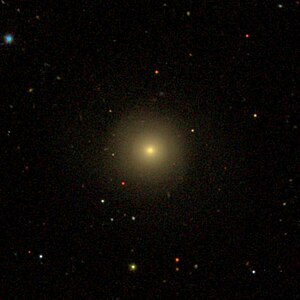NGC 3971
| Galaxy NGC 3971 / NGC 3984 |
|
|---|---|

|
|
| SDSS recording | |
| AladinLite | |
| Constellation | Big Bear |
|
Position equinox : J2000.0 , epoch : J2000.0 |
|
| Right ascension | 11 h 55 m 36.4 s |
| declination | + 29 ° 59 ′ 45 ″ |
| Appearance | |
| Morphological type | S0 |
| Brightness (visual) | 12.8 mag |
| Brightness (B-band) | 13.8 mag |
| Angular expansion | 1.4 ′ × 1.2 ′ |
| Position angle | 30 ° |
| Surface brightness | 13.2 mag / arcmin² |
| Physical data | |
| Redshift | 0.022489 +/- 0.000173 |
| Radial velocity | 6742 +/- 52 km / s |
|
Stroke distance v rad / H 0 |
(301 ± 21) x 10 6 ly (92.2 ± 6.5) Mpc |
| history | |
| discovery | Wilhelm Herschel |
| Discovery date | February 3, 1788 |
| Catalog names | |
| NGC 3971/3984 • UGC 6899 • PGC 37443 • CGCG 157-054 • MCG + 05-28-047 • 2MASX J11553641 + 2959452 • GC 2624 • H II 724 • h 1019 • | |
NGC 3971 = NGC 3984 is a lenticular galaxy of the Hubble type S0 in the constellation Great Bear in the northern sky . It is estimated to be 301 million light years from the Milky Way .
The object was discovered on February 3, 1788 by the astronomer Wilhelm Herschel .
